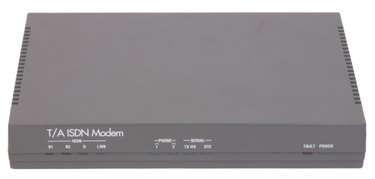
Modems are used to transmit digital information via analog systems. The word "modem" is derived from the term "modulator-demodulator." The essential functions of a modem are to modulate an analog carrier signal to carry digital information; and to demodulate a similar signal so as to decode the digital information from the analog carrier signal.
Modulated Signals
Video of the Day
The essential function of a modem is to create an easily transmitted and decoded signal that allows digital data to be sent from place to place without the loss of information. The most familiar use of modems is to send information over a telephone channel, but modems can be used to relay data over any system that provides a means of transmitting analog signals, including radio and optical networks.
Video of the Day
Data Compression
To reduce the amount of time it takes to send data and to cut down on the amount of error in the signal, modems need to employ data compression. This was especially necessary in the early days of modem technology, since data had to be sent via conventional phone lines. Not being designed for digital information, phone lines placed heavy limitations on the size and speed of signals sent over them. Data compression techniques reduce the size of the signal needed to send the required data.
Error Correction
When information is transmitted between modems, it can sometimes be damaged -- meaning that parts of the data are altered or lost. To get around this, modems use error correction. Information is grouped into batches, called frames. Each frame is tagged with a checksum, a small piece of data derived from the information in the frame. A checksum can be thought of as a kind of fingerprint, unique to the data in a particular frame. The modem that receives the information derives its own checksum from the frame it has been sent, then compares its checksum data with the checksum sent by the transmitting modem. If the checksums match, the information is undamaged. If they don't match, the data has been corrupted in transmission; the recieving modem sends it back and waits for the transmitting modem to re-send that frame.
Flow Control
Individual modems send information at different speeds. It's necessary for faster modems to slow down so that slower modems can catch up, otherwise the slower modem will receive more data than it can process. If this starts to happen, the slower modem transmits a character to the faster one. This character is a signal for the fast modem to pause in sending information until the slow modem gets caught up. When the slow modem is ready for more data, it sends a different character that signals to the fast modem that it can start transmitting again. In this way, the two modems can match their speeds.
Modem Speed Classification
The speed of a modem is typically classified by the amount of data it can send in a specific length of time. This is generally expressed in terms of bits per second (bps). An alternative way of classifying modem speed is the change in the state of the signal per unit time -- the number of times a modem sends a new signal in a given length of time. This is known as the symbol rate and is measured in units called baud (Bd).
Internal vs. External Modems
An external modem is a discrete unit housed in a separate case. Typically, an external modem will be connected to the telephone line and the computer via cables. Internal modems are circuit boards that plug into a computer's motherboard. Internal modems can be dial-up or wireless (Wi-Fi). Dial-ups use the telephone network to send and receive signals. They require authentication to connect. Dial-up is markedly slower than other kinds of modem connection -- as of the date of publication, the fastest listed speed for a dial-up modem is 56.6 Kbps. Wi-Fi modems don't need to be connected to the telephone network and do not always require authentication.
Broadband: Cable and ADSL Modems
Cable modems use the same radio frequency range as cable television. Cable modems have the advantage of using the existing cable television infrastructure, allowing cable TV companies to provide Internet services. Asymmetric Digital Subscriber Line (ADSL) modems use telephone lines to send and receive data but make use of a different frequency band than modems using the voiceband range of frequencies. ADSL modems are much faster than conventional voiceband modems. ADSL and cable modems are used to provide broadband Internet, which allows more data to be transmitted and thus makes using the Internet faster.